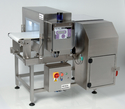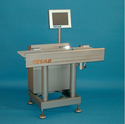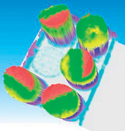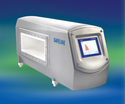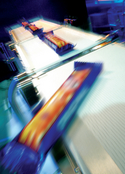Time to shape up
12 June 2007Directives from Brussels are destined to bring about immense changes for the better for makers and users of checkweighers, while the metal detection sector will profit from advanced 2-channel digital signal processor technology. Rod Abbott reports
Checkweigher makers and users should be ensuring that their machinery really does come up to scratch, especially in light of the new European Measuring Instruments Directive warns Loma-Cintex product manager Alan Johnson.
“At the moment, the UK does not require checkweigher manufacturers to guarantee the accuracy, functionality and reliability of their machinery by any standardised benchmark,” he says. “Machinery such as this can suffer from a number of costly faults such as inaccuracy, weight drift and intermittent 'freezing', all resulting in incorrect machine statistics.”
In light of these potential issues, Europe introduced the International Organisation of Legal Metrology R51 approval programme a few years ago. “Although sometimes arduous,” says Johnson, “R51 has helped to guarantee high levels of accuracy and performance with strict metrological and functional standards. However, with Europe generally moving towards a 'single market', a more harmonised system for measuring instruments is on the horizon.”
A conclusive step towards these common European requirements on measuring instruments for trade and communication in the UK was taken when the Measuring Instruments Directive - Directive 2004/22/EC - was recently adopted in parliament.
Supported by WELMEC, whose principal aim is to establish a harmonised and consistent approach to European legal metrology, the 30 member countries are now gearing up for this more thorough and important change.
“Unlike R51 which has to be gained in each country where approval is sought, this new directive means that one approval by one notified body will give manufacturers access to the entire EU market for a variety of measuring instruments. Although the MID replaces R51 on 31 October, machinery already with R51 approval will still be lawful until the expiry date on the certificate.”
Although some European countries - including the UK ¬- are currently deregulated markets, it would seem foolhardy for manufacturers to ignore the MID, if only because the industry would begin to lag behind European technology and not be able to develop fresh sales opportunities.
It would be equally foolhardy for food suppliers to invest in machinery without the assurances of the highest levels of accuracy, reliability and functionality guaranteed by the EU regulations. Like it or not, we are moving towards single market conditions and national markets can no longer be protected by national rules.
The disciplines of checkweighing and metal detection, for so long independent of one another, have at last been joined together in marriages of convenience. Indeed, Loma has produced an X-weigh system that enables the X-ray system to weigh the product while simultaneously inspecting for foreign body contaminants in one compact and easy to use format.
The combination of the two technologies ensures that food manufacturers' produce is safe and products are consistent in weight, size and shape. The X-weigh is reputed to be unaffected by pack rate, speed, vibration, air turbulence, pack orientation or stability and supports a comprehensive reports package showing trends, give-away and batch analysis. Ethernet can network the statistical information that the software provides to a central plant computer or SCADA system.
The Loma X-weigh allows for multi-lane checkweighing, which means a number of lines can be run through the system with each pack inspected according to its own target weight parameters. It also offers combined weighing and object checking, which will ensure that packs with more than one weight zone are compliant for both overall pack weight and individual weight zones. This makes it suitable for inspecting consumer-ready products such as packs of ready meals and snack products.
Advanced Dynamics' Tesab TC 3 checkweigher is an automatic, stainless steel machine with Windows XP-based management software. This new system has been designed in stainless steel to improve efficiency and traceability through the food chain and aims to help food processors comply with the recent traceability laws enforced in January 2005 under the EU's General Food Law legislation (178/2002).
Capable of handling pack weights between 10g and 40kg, at speeds of up to 75packs/min, it features an easy clean design, multi-lane use with touch screen control, feedback and data management in percentage terms and on-line networking capabilities. Options include a combination metal detector, easily removable conveyors, a printer for data management and a scanner for multi-product batches and alternative rejects.
Advanced product recognition technology is one of several new features on the latest checkweigher range from Ishida Europe. The DACS-W series can be specified with a camera that allows pack images to be stored in the checkweigher for immediate recognition, enabling product set-up and changeovers to be carried out in seconds without additional operator intervention.
Ishida's digital signal processing chip is said to permit accurate signal processing under a range of weighing conditions, while the Ishida built load cell achieves high sensitivity, response and accuracy. Combined with a light weigh conveyor, direct drive motor and a low friction belt, Ishida says that the DACS-W-012 can handle products from 10g-1.2 kg at up to 270 packs/min. A range of belt and conveyor sizes is available to suit the size of individual products in order to optimise pack handling and product throughput. Options include an integrated, high performance metal detector.
According to S+S Inspection managing director Richard Lines, the main developments in the technology of contamination in food products are improvements in the sensitivity and ease of operation to minimise the risk of operator error by the use of advanced 2-channel digital signal processors. These provide fully automatic monitoring, calibration and product effect compensation.
The increasing use of metallic containers, especially for ready-meals, requires the use of X-ray to reliably detect both metallic and non-metallic contamination to fully meet consumer protection and IFS and HACCP stringent hygiene standards. An added benefit of X-ray inspection is the ability to detect flavour clumping and under or overfilled containers simultaneously with foreign body detection.
In parallel with improvements in contamination and product fault detection, the accuracy and reliability of rapid-acting mechanical or pneumatic devices - reject flaps, pneumatic pushers, extraction systems or air blast units - has also been improved allowing faster production rates to be achieved.
Inspecting for metallic contamination is a well-developed technology that has become more effective and flexible with the increased use of digital processing to simplify setting-up and provide data logging for quality assurance recording. Often the problem is one of restricted space availability for the detection equipment and manufacturers have responded with new detectors that are small, adaptable and have the control system mounted separately.
Typical of this approach is the new Rapid metal detector/separator system from S+S. The detector unit is connected to the reject diverter by Jacob's quick release fasteners. The two-part design allows the separation mechanism to be rotated through 180º and the drop height can be adapted to meet all installation requirements. The remotely mounted control system uses 2-channel phase technology combined with digital processing and automatic self-calibration to increase performance reliability and consistency of metal detection while simplifying operation and increasing productivity. The auto-learn capability minimises set-up time.
Designed specifically for the detection and separation of metal contamination in free-falling, bulk materials, the Rapid Vario series detects and separates very small contaminants, both magnetic and non-magnetic. Although designed primarily for inspecting re-granulated and virgin feedstock in the plastics industry, the separator is equally suitable for any application requiring reliable inspection of any free-falling, dry material, such as the food industry. For end of line applications where metallised film is used, the S+S Genius multiple frequency control system is designed to automatically select the appropriate frequency for the product and wrapping material properties.
Loma Systems IQ3 metal detector range is reputed to deliver a quantum leap in immunity from vibration, electrical interference, case distortion and thermal shock. The system can be built with a variety of head sizes and meets IP69K 'harsh environment' wash down specifications with enhanced protection for high temperatures.
The IQ3 can operate at any frequency between 40kHz and 900kHz and is said to select the “correct” operating frequency in seconds. Sensitivity to metal in the product, especially stainless steel, is a function of the operating frequency of the metal detector. Operators can optimise performance over a range of products, where new products are continually being introduced such as those in the chilled food industry or where there is a need to frequently change metallic packaging materials. With increased flexibility, the IQ3 is said to be “easily adaptable” to new products, or switched to other production lines or manufacturing plants.
The IQ3 features the company's Performance Validation System, which automatically prompts the operator to test the performance at pre-set intervals to HACCP principles. Object linking and embedding for process control allows operations managers to view data from their metal detector alongside information from other equipment on the production line.
“Profile technology is where the future for metal detection lies,” says Mettler-Toledo's sales and service manager Mike Bradley. “Designed with highly automated food production plants in mind, and with an emphasis based on future requirements, the Mettler-Toledo's Safeline R Series Profile detectors features intuitive windows style icon-driven software routines, a multi-frequency detection coil system and a fail-safe condition monitoring technology.”
The units also carry Ethernet communication capability, real time histogram displays of product data and a 'change-free running' mode which allows numerous product types that exhibit a product effect to be inspected without the need to change detector settings or programs.
The Profile's new colour touch screen and windows-style control panel give access to a “host of new features” to assist in user validation and performance monitoring. Real time histograms display product data characteristics while the memory stores data on each product that passes through it which can prove invaluable for QA and performance qualification purposes.
The R Series Profile is able to record detector usage and provide information on product throughput for traceability and proof of compliance. “Simplicity, security and stability remain the overriding requirements,” adds Bradley. Safeline's Profile technology will initially be available on conveyorised throat and gravity fall metal detectors.
Recognising that there is often little to differentiate inspection systems in today's market, Fortress continue to focus on ease of use for the operation and maintenance staff. The facility to save and recall multiple products within the Fortress Phantom metal detector has been developed to keep the system simple yet reliable in operation.
Packaging materials, product densities and characteristics all have a major impact on the ability of any inspection device to detect a contaminant. With a metal detector this is particularly true with what are called wet (conductive) products. To the producer this change may not be evident but to any modern day metal detector these changes can be significant.
Inaccurate settings on the detector can result in an unacceptable level of false rejects or poor levels of sensitivity/contaminant detection. When false rejects become excessive, it is not unusual for the user to make the detector less sensitive or, in extreme conditions, simply switch it off. It is therefore essential that the detector be capable of learning these changes quickly.
The calibration on the Phantom allows the detector to immediately learn and store the characteristics of each of the individual products. Often it just takes an individual pack to achieve this, thereby minimising any interruption to production. A single key press initiates this function but for some products, which can change over a production run, calibration can be automatic. In these circumstances limit controls ensure that contaminated product can not be learnt and ignored.
The Phantom model includes a number of failsafe features to ensure that any automatic reject device is checked for accurate and reliable operation. Immediate alarms are generated in order to warn the operator if product fails to enter the reject bin or if there is the potential of failure such as insufficient air to operate the pneumatic reject.
Regular testing of the machine can be scheduled by a timed quality alarm, which will prompt the operator to pass test packs. Results of quality testing and fault logs can all be captured, time stamped and reported using the data capture system which can be linked into the factory's existing computer network.
Contact details
Advanced Dynamics
T: +44 (0)1274) 220300
www.advanceddynamics.co.uk
Fortress Technology (Europe)
T: +44 (0)1295 256266
www.fortresstechnology.co.uk
Ishida Europe
T: +44 (0)121 607 7700
www.ishidaeurope.com
Loma-Cintex
T: +44 (0)1252 893300
www.loma-cintex.com
Mettler-Toledo
T: +44 (0)116 2357070
www.mt.com/pi
S+S Inspection
T:+44 (0)1489 889824
www.splussinspection.co.uk
